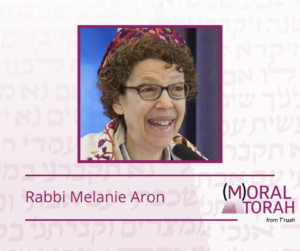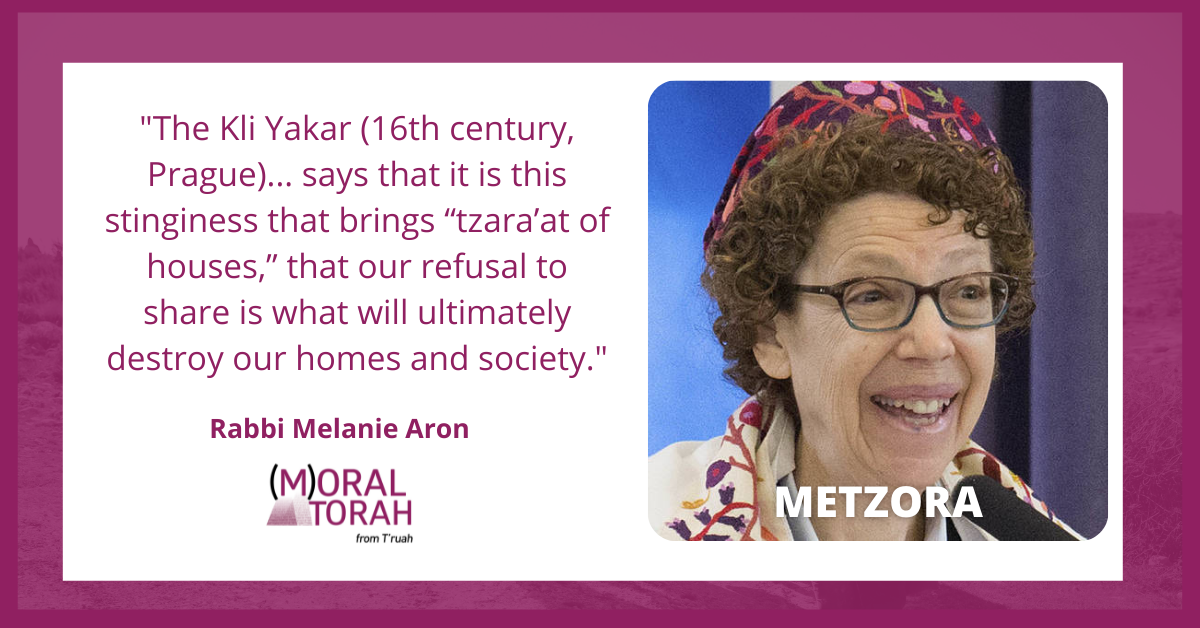A D’var Torah for Parshat Metzora by Rabbi Melanie Aron
Anyone who has ever had water damage in their home can relate to the Levitical passage about tzara’at of walls (Leviticus 14:33-57) found in Parshat Metzora. Yes, the mysterious skin disease can also afflict houses, which can result in having to rebuild a wall or an entire building. Deciding when things can be repaired and when one has to tear it all down and start over is critical. Having to tear out sheetrock and flooring to dry out one’s home is a large and unpleasant undertaking.
The classic midrash in Leviticus Rabbah 17:7 suggests that the Canaanites hid gold in their homes pre-conquest and that the destruction related to the elimination of tzara’at gives the Israelites access to these treasures. This is problematic on many levels. I prefer our tradition of considering the “leprosy” of walls something that “lo hayah ve-lo nivrah”(Tosefta Negaim 6:1), that doesn’t exist in real life and whose purpose is theoretical. This means that there is another message in these texts. What might it be?
Rabbi Samson Raphael Hirsch, the 19th century intellectual founder of Modern Orthodoxy, sees these laws as not about sanitary issues relating to mold but carrying a moral message. He notes that it is tzara’at specifically of walls – that is, of the part of the house that separates the owner from the community. When an owner acts as if his house is his alone, when his “egotism makes a man refuse to render brotherly service to his fellow man,” he is practicing the selfishness of the city of Sodom, where their motto was, “What I have is mine and what you have is yours.”
Sign up to receive (M)oral Torah in your inbox each week.
Pirkei Avot 5:10 at first identifies this as a common characteristic but then remarks that it is the way of Sodom:
There are four types of character in human beings:
One that says: “mine is mine, and yours is yours”; this is a commonplace type; and some say this is a Sodom-type of character.
[One that says:] “mine is yours and yours is mine” is an unlearned person
[One that says:] “mine is yours is yours is yours” is a pious person.
[One that says:] “mine is mine, and yours is mine” is a wicked person.
For many in American society today, it seems adequate to avoid the wicked person’s assertion that “what’s mine is mine and what’s yours in mine” and to live a life of “what’s mine is mine and what’s yours is yours.” It is a theme I hear often, particularly in libertarian circles where ownership is preeminent and there is little sense of community responsibility.
Jewish tradition believes that it is a form of hubris to say that what we have is a result of our own strength and thus belongs to us alone. This theme is enunciated in Deuteronomy’s (8:12-18) fear that in times to come farmers in Israel will become haughty through their possessions. It comes through clearly also in the Talmud in Arachin 16a, where it is asserted that it is haughtiness that makes us claim that we made our house by ourselves and that therefore we don’t have to share. The Kli Yakar (16th century, Prague) similarly says that it is this stinginess that brings “tzara’at of houses,” that our refusal to share is what will ultimately destroy our homes and society.
Find more commentaries on Parshat Metzora.
Many American Jews claim that we pulled ourselves up by our bootstraps, implying that others should do the same. Yet we forget the benefits that our grandparents enjoyed in receiving a good free public school education, and a free university education as in New York’s CUNY system. Often our grandparents benefited from the GI Bill post-World War II, as well as government help in buying homes and other wealth creation. Rabbi Joel Fleekop has a wonderful exercise helping American Jews identify these sources of governmental assistance.
Those at the bottom of the socioeconomic ladder today do not have those extra handholds and footholds to help them progress. It is our responsibility, therefore, to fight for the allocation of resources to these stepping stones. Adequate funding for elementary and secondary education would be a good start, along with programs such as summer school to help students catch up from their Covid-related deficits.  Debt forgiveness for college loans and programs to provide forms of free tuition would go even further. Without these programs, including some form of reparations, we are not facing up to the impact of generations of hurdles like redlining that have prevented others from experiencing our blessings. We are acting like those who brought tzara’at on their homes in earlier times.
Debt forgiveness for college loans and programs to provide forms of free tuition would go even further. Without these programs, including some form of reparations, we are not facing up to the impact of generations of hurdles like redlining that have prevented others from experiencing our blessings. We are acting like those who brought tzara’at on their homes in earlier times.
Rabbi Melanie Aron is the rabbi emerita of Congregation Shir Hadash in Los Gatos, California, where she served for 30 years after a decade on the East Coast in New Jersey and Brooklyn. Through her career, she was involved in justice issues including working with the labor movement, community organizing, and inter-religious dialogue. Currently in Washington DC, she is enjoying teaching, time with family and friends, and participating in Jewish life as a civilian as she did before rabbinical school.

